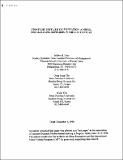Strategic Supplier Segmentation: A model for managing suppliers in the 21st Century
| dc.contributor.author | Chu, Wujin | |
| dc.contributor.author | Dyer, Jeffrey | |
| dc.contributor.author | Cho, Dong Sung | |
| dc.date.accessioned | 2002-07-10T15:14:55Z | |
| dc.date.available | 2002-07-10T15:14:55Z | |
| dc.date.issued | 1996-12-01 | |
| dc.identifier.uri | http://hdl.handle.net/1721.1/1438 | |
| dc.description.abstract | This study of 453 supplier-automaker relationships in the U. S., Japan, and Korea examines the extent to which automakers manage their "arms-length" and "partner" suppliers differently. The findings indicate that U.S. automakers have historically managed all of their suppliers in an arms-length fhshion, Korean automakers have managed all suppliers as partners, and Japanese automakers have segmented their suppliers and have somewhat different relationships depending on the nature of the component. Only Japanese automakers (Toyota and Nissan) have strategically segmented suppliers in such a way as to realize the benefits of both the arms-length and partner models of supplier management. We argue that firms should think strategically about supplier management, and perhaps should not have a "one size fits all" strategy for supplier management. | en |
| dc.format.extent | 1404652 bytes | |
| dc.format.mimetype | application/pdf | |
| dc.language.iso | en_US | |
| dc.relation.ispartofseries | IMVP;144a | |
| dc.subject | automakers | en |
| dc.subject | Nissan | en |
| dc.subject | supplier management | en |
| dc.subject | Toyota | en |
| dc.title | Strategic Supplier Segmentation: A model for managing suppliers in the 21st Century | en |
Files in this item
This item appears in the following Collection(s)
-
International Motor Vehicle Program
Research on automotive industry dynamics from assembly to the extended enterprise, from e-business to sustainability

